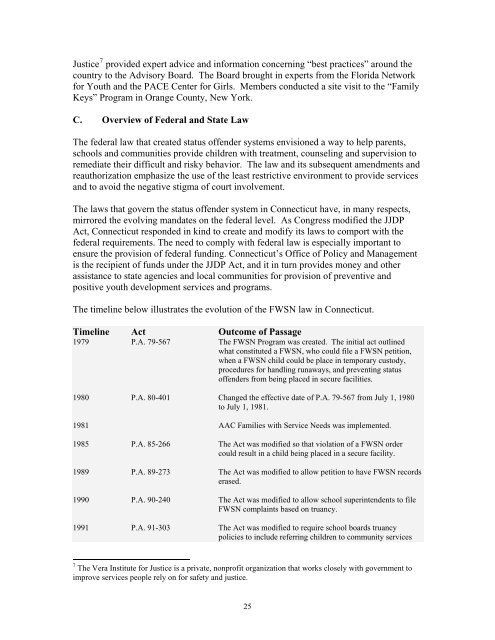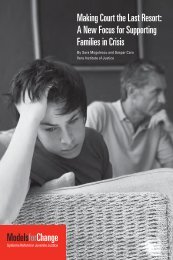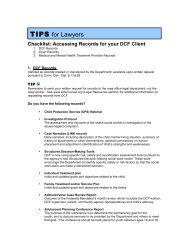FWSN-advisorybd-repo.. - The Connecticut Juvenile Justice Alliance
FWSN-advisorybd-repo.. - The Connecticut Juvenile Justice Alliance
FWSN-advisorybd-repo.. - The Connecticut Juvenile Justice Alliance
You also want an ePaper? Increase the reach of your titles
YUMPU automatically turns print PDFs into web optimized ePapers that Google loves.
<strong>Justice</strong> 7 provided expert advice and information concerning “best practices” around the<br />
country to the Advisory Board. <strong>The</strong> Board brought in experts from the Florida Network<br />
for Youth and the PACE Center for Girls. Members conducted a site visit to the “Family<br />
Keys” Program in Orange County, New York.<br />
C. Overview of Federal and State Law<br />
<strong>The</strong> federal law that created status offender systems envisioned a way to help parents,<br />
schools and communities provide children with treatment, counseling and supervision to<br />
remediate their difficult and risky behavior. <strong>The</strong> law and its subsequent amendments and<br />
reauthorization emphasize the use of the least restrictive environment to provide services<br />
and to avoid the negative stigma of court involvement.<br />
<strong>The</strong> laws that govern the status offender system in <strong>Connecticut</strong> have, in many respects,<br />
mirrored the evolving mandates on the federal level. As Congress modified the JJDP<br />
Act, <strong>Connecticut</strong> responded in kind to create and modify its laws to comport with the<br />
federal requirements. <strong>The</strong> need to comply with federal law is especially important to<br />
ensure the provision of federal funding. <strong>Connecticut</strong>’s Office of Policy and Management<br />
is the recipient of funds under the JJDP Act, and it in turn provides money and other<br />
assistance to state agencies and local communities for provision of preventive and<br />
positive youth development services and programs.<br />
<strong>The</strong> timeline below illustrates the evolution of the <strong>FWSN</strong> law in <strong>Connecticut</strong>.<br />
Timeline Act Outcome of Passage<br />
1979 P.A. 79-567 <strong>The</strong> <strong>FWSN</strong> Program was created. <strong>The</strong> initial act outlined<br />
what constituted a <strong>FWSN</strong>, who could file a <strong>FWSN</strong> petition,<br />
when a <strong>FWSN</strong> child could be place in temporary custody,<br />
procedures for handling runaways, and preventing status<br />
offenders from being placed in secure facilities.<br />
1980 P.A. 80-401 Changed the effective date of P.A. 79-567 from July 1, 1980<br />
to July 1, 1981.<br />
1981 AAC Families with Service Needs was implemented.<br />
1985 P.A. 85-266 <strong>The</strong> Act was modified so that violation of a <strong>FWSN</strong> order<br />
could result in a child being placed in a secure facility.<br />
1989 P.A. 89-273 <strong>The</strong> Act was modified to allow petition to have <strong>FWSN</strong> records<br />
erased.<br />
1990 P.A. 90-240 <strong>The</strong> Act was modified to allow school superintendents to file<br />
<strong>FWSN</strong> complaints based on truancy.<br />
1991 P.A. 91-303 <strong>The</strong> Act was modified to require school boards truancy<br />
policies to include referring children to community services<br />
7 <strong>The</strong> Vera Institute for <strong>Justice</strong> is a private, nonprofit organization that works closely with government to<br />
improve services people rely on for safety and justice.<br />
25
















